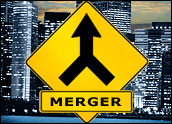
About three years ago, it seemed as though reverse mergers were falling out of favor with the SEC. The agency sanctioned some of the companies that were created by this process and some were actually suspended from trading.
Now it seems that reverse mergers are once again regaining their popularity. The SEC seems to have learned to live with this somewhat novel way of going public by the “back door.”
What Is a Reverse Merger?
A reverse merger usually occurs when an operating company is “acquired” by a publicly traded company that has no operations and no income — a shell. The shareholders of the operating company end up with a majority ownership in the shell.
This occurs because, as part of the merger transaction, the shell corporation issues a large amount of shares to the shareholders of the operating company, thus leaving the shell stockholders with a minority position (not infrequently about 10 percent).
A typical reverse merger transaction occurs when a profitable company — the operating company — wants to go public but doesn’t want to spend the time and money for a full-blown, underwritten IPO (initial public offering). To achieve the goal of having its stock publicly traded, the operating company agrees to be “acquired” by a shell company that is publicly traded.
The shell company is usually a company that was once quite active as an operating company but encountered some difficulties, such as bankruptcy, lack of sales, or its products become obsolete.
What it has going for it is a stockholder base, a trading symbol, and the fact that it already has gone through the hoops of a public offering.
Therefore, when an active operating company wants the quick route to being publicly traded, it is not uncommon for it to “be acquired” by a shell corporation, but then emerge as the dominant shareholder of the shell corporation after the acquisition.
How Common Is a Reverse Merger?
Actually, reverse mergers have become quite common and they no longer carry the stigma that they once did. Not too many years ago, a company that went public through a reverse merger was regarded as being somewhat “tainted.” Some investors would keep away from buying the stock of a company that became public through a reverse merger.
One of the reasons for this is that the stock of the newly merged, public company was commonly traded for less than US$1. Therefore, it garnered the reputation as just another penny stock.
Today, however, some very reputable operating companies have become public in this fashion and their stock is traded in a quite respectable range — certainly well over $1. Therefore, I think that we will see more of this type of transaction and the resulting entity.
What to Be Cautious About
I always tell our clients who are considering a reverse merger that their main concern should be that the shell they intend to use to create a publicly traded vehicle for their operating company is “clean.”
There should be a thorough investigation about any contingent liabilities and left over regulatory issues that the shell might have. The only way to do this is by a thorough due diligence process of the prospective shell corporation.
This process should focus on the existence of hidden liabilities that the shell may have. It should also look at contingent liabilities, such as possible lawsuits or unsettled claims.
Another focus should be whether or not any actual or contingent regulatory problems exist. For example, are there any outstanding actions by the SEC or other regulatory agency against the shell corporation?
These concerns can best be handled by a competent CPA firm and a competent law firm.
What to Expect
Going public is not for everyone. There are regulatory filings that must be made. There is scrutiny of your company in the public domain.
There are also some very rewarding upsides. Mainly, your company will most likely be worth a great deal more if its stock is publicly traded. Also, your ownership interest will now be liquid in that, given certain regulatory restrictions, you can much more readily sell some or all of your ownership interest — thus giving you, your family, and your estate far more liquidity than you would otherwise have as a privately held corporation.
For a more detailed description of this process, please see my articles “Is Your Company IPO Material,” and “Is Going Public the Right Move for Your Company?”
Becoming Popular Again
The recent reverse merger that our firm was involved in made me aware that this type of transaction no longer has the stigma that it once had. Regulators, though expecting a company to meet all of its requirements, no longer look askance at this method of going public.
So, if you are considering such an option, realize that it has become quite common and might just be the quickest way to bring your company public.
Good luck!
Theodore F. di Stefano is a founder and managing partner at Capital Source Partners, which provides a wide range of investment banking services to the small and medium-sized business. He is also a frequent speaker to business groups on financial and corporate governance matters. He can be contacted at [email protected].




















































Social Media
See all Social Media